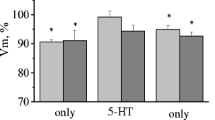Abstract
The intestinal nerve was stimulated in combination and uncombined with extracellular stimulation of the mesocerebral region of the brain, as well as with stimulation of serotoninergic neurons, in experiments on a preparation of the isolated CNS of the common snail, with preservation of the nerve connections with the sexual system. Reponses were recorded in command neurons of defense behavior. The data were obtained indicating that, in the case of combinations with extracellular stimulation of the mesocerebrum, an analog of a conditioned reaction of diminution of EPSP in the command neurons of the serotoninergic neurons, sensitization appears, both in the case of combined and uncombined presentation of the stimuli.
Similar content being viewed by others
References
É. A. Asratyan, Essays on the Physiology of the Conditioned Reflexes [in Russian], Nauka, Moscow (1970).
P. M. Balaban and I. S. Zakharov, Learning and Development. General Foundations of the Two Phenomena [in Russian], Nauka, Moscow (1992).
O. A. Maksimova and P. M. Balaban, “The reinforcing action of stimulation of the mesocerebral region of the brain of the common snail,” Zh. Vyssh. Nerv. Deyat.41, No. 2, 391 (1991).
L. A. Piruzyan, O. A. Maksimova, and P. M. Balaban, “The neuronal correlates of the classical conditioned reflexin vitro,” Dokl. Akad. Nauk SSSR,270, No. 3, 751 (1983).
P. M. Balaban and R. Chase, “Self-stimulation in snail,” Neurosc. Res. Comm.,4, 139 (1989).
P. M. Balaban and R. Chase, “Interrelations of the emotionally positive and negative regions of the brain of the edible snail,” Neurosc. and Behav. Physiol.,21, 172 (1991).
R. Chase, “Brain cell [sic] that command sexual behavior in the snail Helix aspersa,” J. Neurobiol.,17, 669 (1986).
I. S. Zakharov and P. M. Balaban, “Serotoninergic modulation of avoidance behavior in Helix.” in: Simple Nervous Systems, D. A. Zakharov and W. Winlow (eds.), Manch. Univ. Press (1991), p. 316.
Additional information
This study was supported by the Russian Basic Research Fund (project No. 94-04-122090).
Institute of Higher Nervous Activity and Neurophysiology, Russian Academy of Sciences, Moscow. Translated from Zhurnal Vysshei Nervnoi Deyatel'nosti imeni I. P. Pavlova, Vol. 45, No. 1, pp. 163–170, January–February, 1995.
Rights and permissions
About this article
Cite this article
Maksimova, O.A. Suppression of synaptic input of defense behavior command neurons by stimulation of neurons of the mesocerebrum in a preparation of the isolated CNS of the common snail. Neurosci Behav Physiol 26, 259–265 (1996). https://doi.org/10.1007/BF02360692
Received:
Revised:
Issue Date:
DOI: https://doi.org/10.1007/BF02360692



